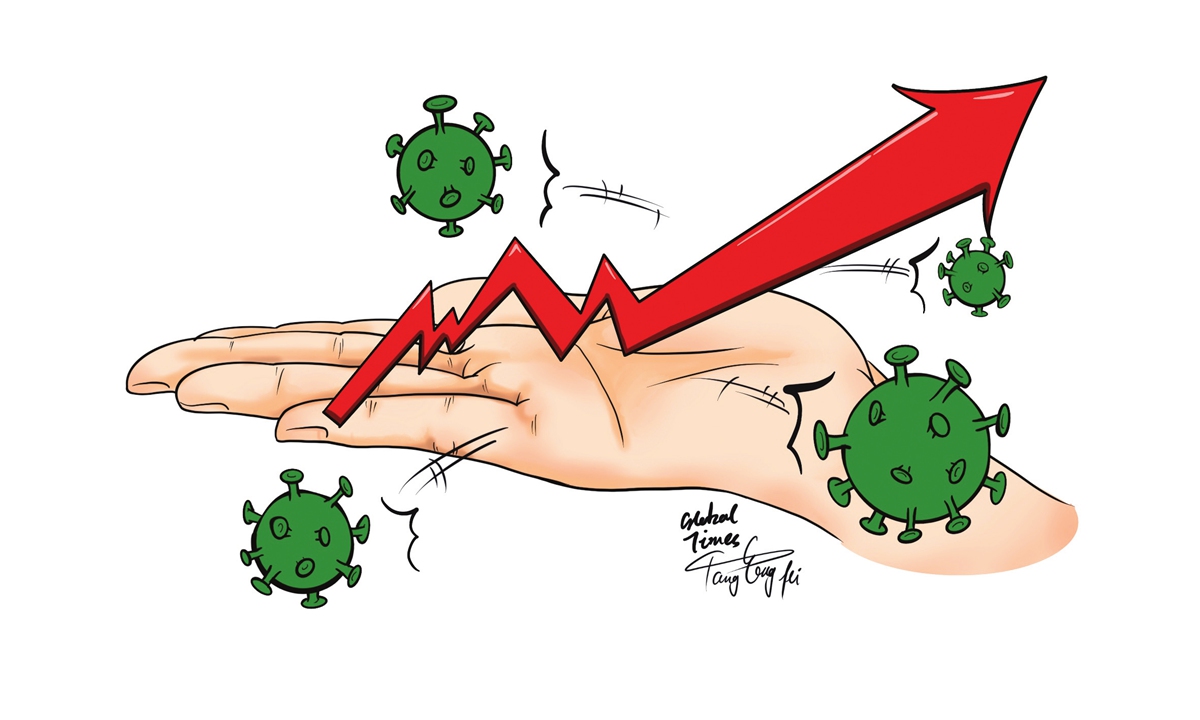
Illustration: Tang Tengfei/Global Times
As many regions in China are going all out to safeguard public health from a new round of COVID-19 infections, Western media outlets, which will take any chance to badmouth China's economy, are once again using the outbreaks as a weapon to attack China's dynamic zero-COVID policy and the Chinese economy.
Bloomberg made an alarmist claim on Monday, suggesting China's anti-epidemic efforts could threaten half of its GDP. Bloomberg's theory is based on the fact that the 14 Chinese provinces, which have high or medium-risk regions, account for 54.4 percent of the national GDP. But the caveat is that not all of those places have completely shut down their economies, far from it. So that calculation is extremely inaccurate.
It's worth noting that Bloomberg last year put the US in the top spot in its COVID-19 resilience ranking, drawing laughs and mockery from Chinese officials and the public.
When using the latest flare-up to attack China's zero-COVID policy, some Western media have compared the current number of cases with the number of the first outbreak in early 2020, but they obviously forgot how China quickly and effectively controlled the epidemic at arguably the minimum cost and fostered an economic rebound through a swift and orderly return to regular economic output.
When the epidemic first emerged in 2020, in the face of this unprecedented public health crisis, it took China just over a month to effectively curb the spread. The central city of Wuhan, which was severely affected by the epidemic, was taken out of lockdown in April, in a major victory against the epidemic. China also has achieved the highest vaccination rate in the world, reaching 80 percent as of last December.
After the severe impact in the first quarter of 2020, China's economy swiftly returned to near full capacity, with the economy returning to positive growth of 3.2 percent in the second quarter and returned to its pre-COVID-19 trajectory of growth - 6.5 percent - in the fourth quarter, making China the only major economy in the world to record positive growth that year.
Then last year, despite sporadic outbreaks within the country and near out-of-control spread in many countries, China's economy posted an 8.1 percent GDP growth, defying market expectations and further cementing the world's second-largest economy's leading position in the global economy's recovery from the ongoing COVID-19 pandemic.
The number of infections and fatalities combined with economic and trade data in the past two years show that China's strict and effective dynamic zero-COVID policy has helped make China one of the most successful countries in fighting the virus. Thanks to the targeted and effective epidemic prevention and control measures, China has been able to maintain its economic growth and contribute to the stability of the global industrial and supply chains, and the growth of the global economy.
Currently facing a more complex epidemic landscape, such as the hidden transmission chains of the Omicron variant, China's adhering to dynamic zero-COVID policy will also snuff out infections as quickly as possible. On the basis of the established measures, including tight border controls, targeted lockdowns, mass testing and digital tracking, China will quickly improve the process to swiftly control the epidemic.
Over the past two years, the strong resilience of China's economy has been fully demonstrated. China's economy can and will overcome the impact of the current epidemic and maintain stable development. Given the Chinese economy's sound fundamentals and unique advantages, as well as policy preparation for uncertainty, it can achieve the stated goal of making progress while maintaining stability this year.
Fully underlining the uncertainties China's economy may face this year, the annual government work report released during the just-concluded two sessions has set an around 5.5 percent economic growth target. Proving more emphasis on effectiveness and flexibility in fiscal and monetary policy arrangements, the report also leaves sufficient room to tackle risks and uncertainties.
Foreign media's overwrought interpretation of Shenzhen's anti-epidemic measures and epidemic prevention policy, and their grossly biased and unscientific economic impact assessments deviate too far from objective analysis. Just as the theory of China's "economic collapse" has failed countless times before, China-bashers' wild predictions this time will also prove to be nothing but noises.
The author is an editor with the Global Times. bizopinion@globaltimes.com.cn




